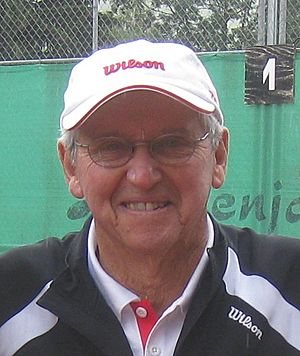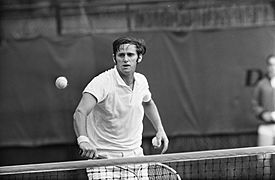Roy Emerson facts for kids
 |
|
| Full name | Roy Stanley Emerson |
|---|---|
| Country (sports) | |
| Residence | Newport Beach, California, U.S. |
| Born | 3 November 1936 Blackbutt, Queensland, Australia |
| Turned pro | 1968 (amateur tour from 1951) |
| Retired | 1983 |
| Plays | Right-handed (one-handed backhand) |
| Int. Tennis HoF | 1982 (member page) |
| Singles | |
| Career record | 1397-416 (77.0%) |
| Career titles | 106 (6 open era titles listed by ATP) |
| Highest ranking | No. 1 (1961, Ned Potter) |
| Grand Slam singles results | |
| Australian Open | W (1961, 1963, 1964, 1965, 1966, 1967) |
| French Open | W (1963, 1967) |
| Wimbledon | W (1964, 1965) |
| US Open | W (1961, 1964) |
| Doubles | |
| Grand Slam doubles results | |
| Australian Open | W (1962, 1966, 1969) |
| French Open | W (1960, 1961, 1962, 1963, 1964, 1965) |
| Wimbledon | W (1959, 1961, 1971) |
| US Open | W (1959, 1960, 1965, 1966) |
| Team competitions | |
| Davis Cup | W (1959, 1960, 1961, 1962, 1964, 1965, 1966, 1967) |
Roy Stanley Emerson (born 3 November 1936) is a famous Australian tennis player. He is considered one of the greatest players in the history of the sport. Emerson won an amazing 28 Grand Slam titles in his career. This includes 12 titles in singles and 16 in doubles.
He is the only male player to have won all four Grand Slam tournaments in both singles and doubles. This is known as a "Career Grand Slam." His 28 major titles are still the most ever won by a male player. For 30 years, he held the record for the most men's singles Grand Slam wins (12) until Pete Sampras broke it in 2000.
Emerson also set a record by winning the Australian Open men's singles title six times. He won five of these in a row from 1963 to 1967, a record that still stands today.
Contents
Early Life and Career
Roy Emerson was born on a farm in Blackbutt, Queensland, Australia. His family later moved to Brisbane, where he got better tennis coaching. He started playing in tournaments when he was just a teenager.
In 1959, he won his first Grand Slam title in doubles at Wimbledon. Two years later, in 1961, he won his first Grand Slam singles title at the Australian Championships, beating his fellow Australian Rod Laver.
Known as "Emmo" to his friends, Emerson was famous for his incredible fitness. He trained very hard, which meant he was always ready for long, tough matches. His main style of play was "serve-and-volley," where he would serve the ball and rush to the net. However, he could also play well on slower clay courts, which helped him win on all types of surfaces.
A Record-Breaking Champion
Dominating the Australian Championships
From 1963 to 1967, Emerson was unbeatable at the Australian Championships. He won the men's singles title five years in a row. His total of six Australian titles was a record until 2019, when Novak Djokovic won his seventh.
Winning Around the World
In 1963, Emerson won his first singles title at the French Championships. The next year, in 1964, he won his first singles title at Wimbledon. The year 1964 was incredible for Emerson. He won 109 out of 115 matches, including 55 in a row. He won three of the four Grand Slam tournaments that year.
Emerson was ranked the world's No. 1 amateur player in 1964 and 1965. During this time, tennis was split between amateur players and professionals. Emerson chose to stay an amateur for most of his peak years. He became a professional player in 1968 when the "Open Era" began, allowing amateurs and professionals to compete together.
His 12th and final major singles title came at the French Championships in 1967.
A Master of Doubles
Emerson was not just a great singles player; he was also one of the best doubles players of all time. He won 16 Grand Slam doubles titles with five different partners. From 1960 to 1965, he and his partners won the French Open men's doubles title six times in a row.
The famous tennis promoter Jack Kramer once said that Emerson was "the best doubles player of all the moderns." He praised Emerson's speed and his ability to hit the perfect shots in a doubles match.
Life After Pro Tennis
Even after he stopped playing in major tournaments, Emerson stayed involved in tennis. In the 1970s, he was a player and coach for the Boston Lobsters team in a league called World Team Tennis.
Today, Emerson lives in Newport Beach, California, with his family. He also has a home in Gstaad, Switzerland, where he runs a tennis clinic every summer. His son, Antony, also became a professional tennis player.
Honors and Legacy
Roy Emerson's amazing career has been recognized with many honors.
- In 1982, he was inducted into the International Tennis Hall of Fame.
- In 1986, he was inducted into the Sport Australia Hall of Fame.
- The main court at the tennis tournament in Gstaad, Switzerland, is named the Roy Emerson Arena in his honor.
- In his home state of Queensland, the trophy for the men's champion at the Brisbane International is named after him.
- A statue of Emerson was unveiled in his hometown of Blackbutt in 2017.
In a 2012 TV special, Emerson was ranked as the 11th greatest male tennis player of all time. He is remembered as a tough, fit, and fair competitor who achieved incredible success in both singles and doubles.
Grand Slam Singles Finals
Emerson played in 15 Grand Slam singles finals and won 12 of them. Here is a list of his wins:
- Australian Open (6): 1961, 1963, 1964, 1965, 1966, 1967
- French Open (2): 1963, 1967
- Wimbledon (2): 1964, 1965
- US Open (2): 1961, 1964
See also
 In Spanish: Roy Emerson para niños
In Spanish: Roy Emerson para niños
- World number one male tennis player rankings
- Tennis male players statistics
- All-time tennis records – men's singles
- Tennis records of the Open Era – men's singles



